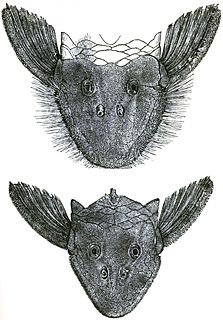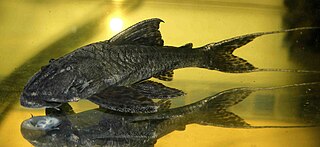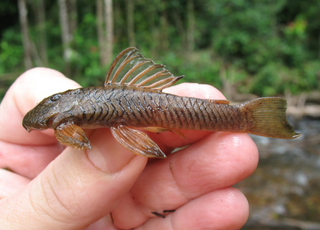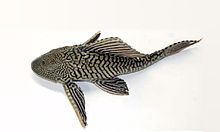
Ancistrus is a genus of nocturnal freshwater fish in the family Loricariidae of order Siluriformes, native to freshwater habitats in South America and Panama. Fish of this genus are common in the aquarium trade where they are known as bushynose or bristlenose catfish. In the aquarium hobby they are often referred to as bushynose or bristlenose plecos instead, but this may lead to confusion as "pleco" usually is used for Hypostomus plecostomus and its allies and is often used as a catchall term for any loricariids remotely resembling that species.

Callichthyidae is a family of catfishes, called armored catfishes due to the two rows of bony plates along the lengths of their bodies. It contains some of the most popular freshwater aquarium fish, such as many species in the genus Corydoras.

Hypostomus plecostomus, also known as the suckermouth catfish or the common pleco, is a tropical freshwater fish belonging to the armored catfish family (Loricariidae), named for the longitudinal rows of armor-like scutes that cover the upper parts of the head and body. Although the name Hypostomus plecostomus is often used to refer to common plecostomus sold in aquarium shops, most are actually members of other genera.

Loricariidae is the largest family of catfish, with 92 genera and just over 680 species. Loricariids originate from freshwater habitats of Costa Rica, Panama, and tropical and subtropical South America. These fish are noted for the bony plates covering their bodies and their suckermouths. Several genera are sold as "plecos", notably the suckermouth catfish, Hypostomus plecostomus, and are popular as aquarium fish.

Hypostomus is a genus of catfish in the family Loricariidae. They are native to tropical and subtropical South America. H. plecostomus is the popular freshwater aquarium fish formerly known as Plecostomus plecostomus. There is a lot of confusion as to the precise taxonomic structure of the Loricariidae.

Pterygoplichthys or commonly known as janitor fish is a genus of South American armored catfishes. These fish are commonly known as sailfin armoured catfish or sailfin plecs.

Baryancistrus is a genus of freshwater Loricariid catfish. They inhabit flowing sections of rivers, especially clearwater, in the basins of the Amazon and Orinoco in Brazil and Venezuela. The largest species reach up to 34 cm (13 in) in total length.

Pseudancistrus is a genus of suckermouth armored catfishes native to South America.

Peckoltia is a genus of small South American armored suckermouth catfishes. Many of these fish are popular aquarium fish.

Hemiancistrus is a genus of suckermouth armored catfishes. These species are native to South America. The taxonomy of this genus is complex and unclear, and major work has to be done. Many of these fish are popular aquarium fish.

Rhinelepini is a tribe of armored suckermouth catfish family within the Hypostominae subfamily.
Ancistomus is a genus of suckermouth armored catfishes found in shallow waters in rapidly flowing rivers in the southeastern Amazon basin in Brazil.
Pogonopoma is a genus of armored catfish native to rivers in south and southeast Brazil.

Loricariinae is a subfamily of the family Loricariidae of catfish. This subfamily is divided into two tribes and about 30 genera. They are mainly native to freshwater habitats in South America, but there are also several species in Panama and a single (Fonchiiichthys) in Costa Rica.

Ancistrini is a tribe of catfishes of the family Loricariidae. Most are restricted to tropical and subtropical South America, but there are also several genus in southern Central America.
Lithoxus is a genus of suckermouth armored catfishes native to tropical South America.

Guyanancistrus is a genus of suckermouth armored catfishes.
Peckoltia relictum is a species of armored catfish where it is found in the upper Marañon River in northern Peru.
Peckoltichthys bachi is a species of armored catfish and the only member of this genus. This species is found throughout the upper Amazon River and its tributaries in Brazil, Colombia, Ecuador, and Peru.
Pterygoplichthys anisitsi also known as the Paraná sailfin catfish, southern sailfin catfish, or snow-king plecostomus, is a species of catfish in the family Loricariidae. Its natural range is the middle Paraná and Uruguay River basins of south-central South America, but it has been introduced to North America and South Asia, probably via the pet trade. As in other loriacartii catfishes, Pterygoplichthys anisitsi has a ventral mouth modified into a sucking disk and a body covered in bony plates. This species typically has a dark and white spotted body pattern, although some individuals are very dark with few spots.












